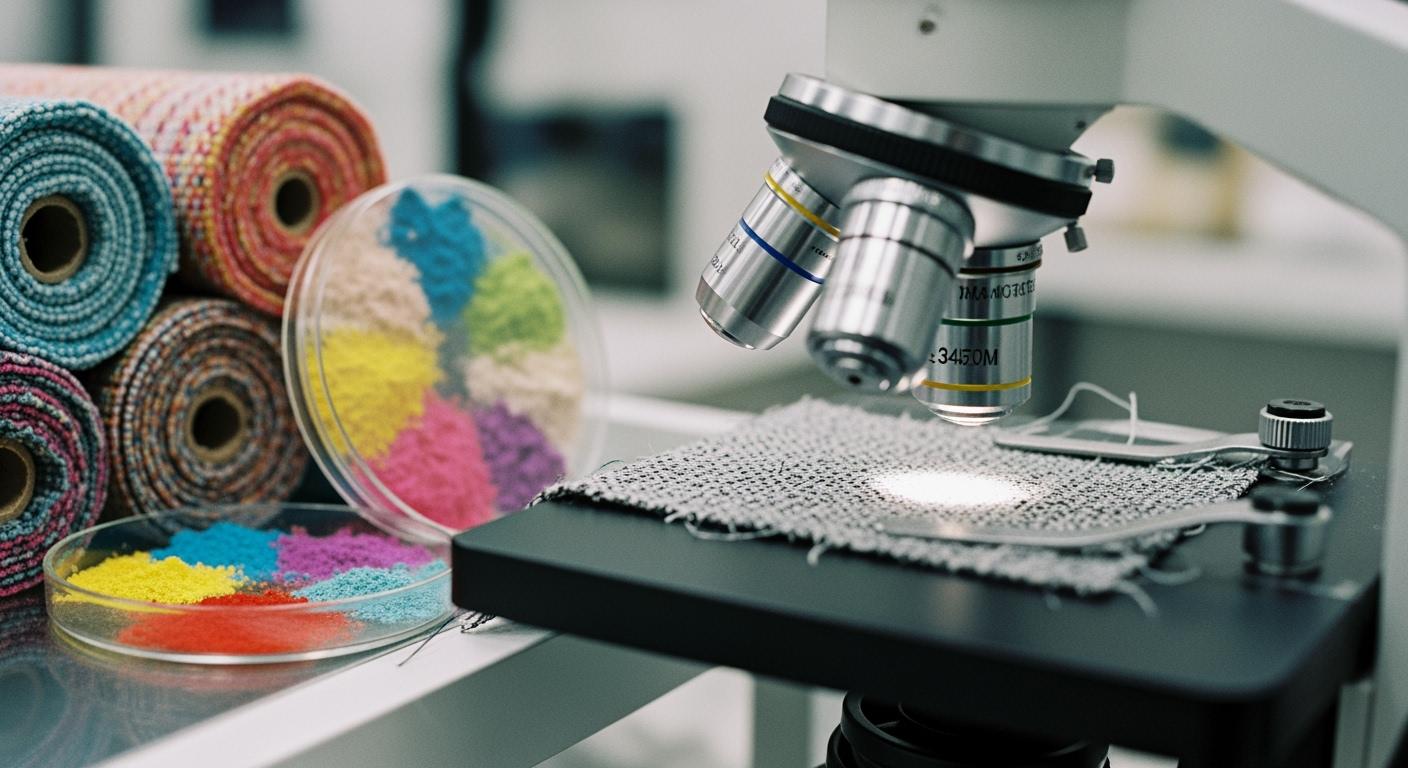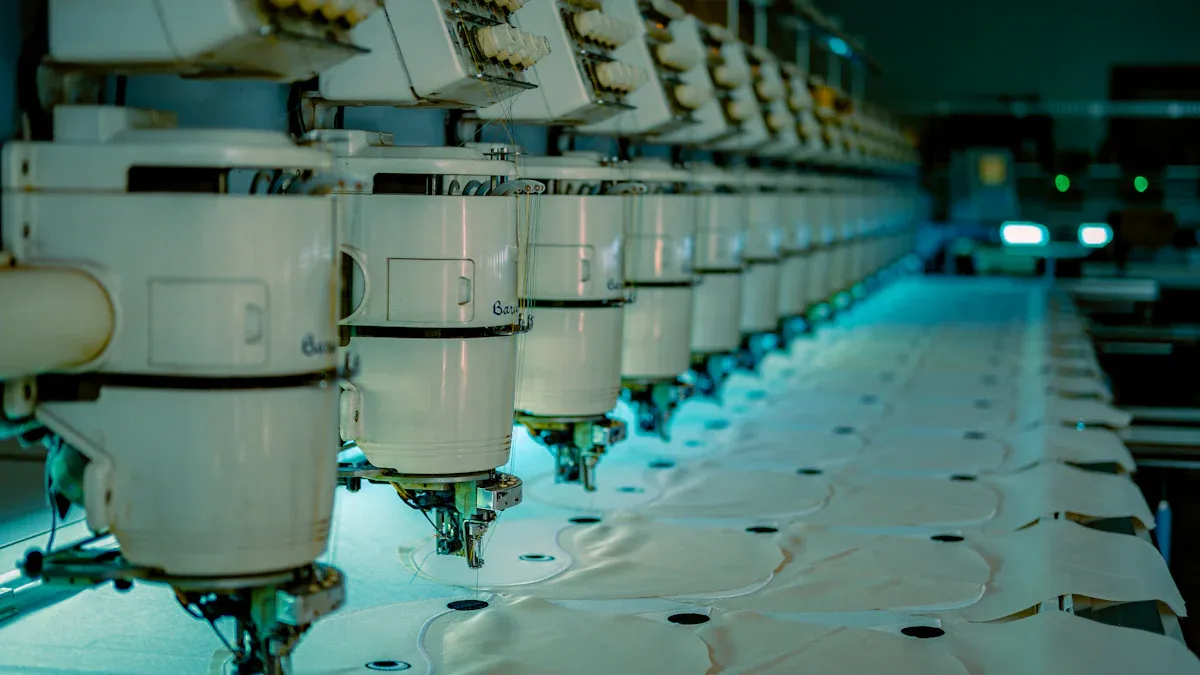
Traditional dyeing methods consume enormous amounts of water. This creates significant environmental challenges.
| Statistic | Value |
|---|---|
| Annual water use by textile industry | 93 billion cubic meters |
| Share of industrial wastewater pollution | 20% |
| Water needed per kilogram of textiles | 200 liters |
A data-driven approach offers a better path for waterless dyeing. It replaces guesswork with precise analysis. This guide explains how to use material data to optimize waterless dyeing technologies. It helps achieve efficient, sustainable results. Success with sustainable dyeing technologies depends on smart material selection, making waterless dyeing a practical reality and promoting long-term sustainability.
Essential Data for Waterless Dyeing Technologies
Successful waterless dyeing depends on understanding the core materials. A data-driven approach helps select the best components for specific waterless dyeing technologies. This ensures efficiency and high-quality results in the waterless dyeing process.
Dye Material Properties
Selecting the right dye is the first step. Key data points include the dye's molecular weight, solubility, and thermal stability. This information predicts how a dye will behave in a waterless medium. For example, smaller dye molecules often diffuse faster into fibers. This knowledge is vital for both supercritical carbon dioxide dyeing and newer digital dyeing technologies. Analyzing these properties helps optimize the waterless dyeing process for better color uptake and fastness.
Fabric Substrate Metrics
The fabric itself presents critical variables for waterless dyeing. Manufacturers must analyze metrics for diverse materials like polyester, cotton, nylon, wool, silk, and bamboo. Fiber type, yarn structure, and fabric construction all influence dye absorption. Fabric porosity is especially important. It determines how easily the dye medium can penetrate the material.
Tip: Porosity can be measured in several ways. These methods help predict dye penetration without damaging the fabric.
Solvent and Medium Parameters
The medium carries the dye to the fabric in waterless dyeing. Its properties are crucial for success. Different waterless dyeing techniques use different mediums. For supercritical CO₂, the phase diagram is essential. It shows the exact temperature and pressure needed to reach the supercritical state.
| Substance | Critical Temperature (K) | Critical Pressure (atm) |
|---|---|---|
| Carbon dioxide | 304.2 | 73.0 |
Above these points, CO₂ has unique properties ideal for waterless dyeing. For other waterless dyeing technologies using silicone or other liquid mediums, viscosity and surface tension data are key. This information helps create sustainable textiles and supports the use of energy-efficient dyeing machines. A sustainable approach to material selection improves overall sustainability.
Analysis Methods for Eco-Friendly Solutions

Gathering data is the first step. The next step is using that data to make smart decisions. Analysis methods turn raw numbers into actionable insights. These methods help manufacturers predict how materials will perform together. This predictive power is essential for developing reliable and sustainable eco-friendly solutions for waterless dyeing.
Modeling Dye-Solvent Compatibility
A successful waterless dyeing process depends on the dye mixing properly with the solvent. If they are not compatible, the dye will not transfer effectively to the fabric. Modeling helps predict this compatibility without costly physical tests.
The Flory-Huggins theory is a classic model for this purpose. It helps understand the mixing behavior of different components. This model uses a key value called the Flory-Huggins parameter (χ). It measures the interaction between two components, like a dye and a solvent.
A low or negative χ value indicates strong attraction and high compatibility. A positive value suggests the materials will separate. In practice, a χ value below 0.5 usually means the materials will mix well.
By calculating this parameter, analysts can screen potential dye-solvent pairs. This ensures the chosen combination will be effective for waterless dyeing, leading to better color uptake and less waste.
Analyzing Dye-Fabric Affinity
Dye-fabric affinity describes how strongly a dye binds to a fabric. High affinity leads to vibrant, long-lasting color that does not fade easily. Intermolecular forces, such as van der Waals forces and hydrogen bonds, are the invisible "glue" that holds dye molecules to fibers in non-aqueous systems. The strength of this bond determines colorfastness.
Analysts use adsorption isotherm models to measure this affinity quantitatively. These mathematical models describe how dye molecules distribute between the solvent and the fabric. Two common models are Langmuir and Freundlich.
- Langmuir Model: This model provides a constant (
KL) that shows the intensity of the dye-fabric interaction. A higherKLvalue means a stronger bond. - Freundlich Model: This model gives a constant (
Kf) that represents the fabric's adsorption capacity, or how much dye it can hold. It also includes a parameter (1/n) for adsorption intensity. A1/nvalue between 0 and 1 indicates favorable adsorption.
Using these models, technicians can predict how well a dye will perform on a specific fabric. This analysis is crucial for ensuring high-quality results in both traditional waterless dyeing and modern digital dyeing technologies.
Using Multi-Criteria Decision Analysis
Choosing the best materials for waterless dyeing involves more than just technical performance. Manufacturers must also consider cost, environmental impact, and safety. Multi-Criteria Decision Analysis (MCDA) provides a structured framework for balancing these competing factors. These advanced techniques help decision-makers select the optimal combination of materials.
Key criteria in an MCDA for sustainable dyeing often include:
- Color performance and yield
- Dyeing cost per kilogram of fabric
- Toxicity of materials
- Energy and water consumption
- Wastewater volume
Several MCDA methods are useful in the textile industry. The Analytic Hierarchy Process (AHP) is one popular method. Companies have used AHP to rank raw material suppliers and improve supply chain management. Another powerful method is the Technique for Order Preference by Similarity to Ideal Solution (TOPSIS). TOPSIS works by ranking alternatives based on how close they are to a perfect, ideal solution. These methods can even be combined to handle complex decisions with greater confidence.
By applying MCDA, manufacturers can move beyond single-factor decisions. They can systematically evaluate their options to find a solution that excels in performance, cost-effectiveness, and sustainability. This approach is vital for advancing waterless dyeing technologies.
Applying Analysis to Waterless Dyeing
Theoretical analysis becomes powerful when applied to real-world challenges. This section outlines a practical workflow using a case study: selecting disperse dyes for polyester fabric in supercritical CO₂ (scCO₂) waterless dyeing. This structured process transforms data into efficient, high-quality outcomes for waterless dyeing.
Initial Data Screening
The first step is to filter the vast number of available materials. Analysts begin with a broad list of potential dyes and fabrics. They use the essential data points to eliminate poor candidates. For our case study, they would screen disperse dyes based on their solubility in scCO₂ and their thermal stability. Dyes that are insoluble or degrade under high pressure are removed. Similarly, they assess different polyester fabrics for their porosity to ensure the medium can penetrate the fibers effectively. This initial screening creates a manageable list of promising materials for waterless dyeing.
Predictive Modeling and Ranking
Next, predictive models rank the screened materials. These models use machine learning to forecast performance without physical tests. Analysts can use various regression models to predict dye uptake based on material properties.
- Gaussian Process Regression (GPR) can predict color values with limited data.
- Artificial Neural Networks (ANN) are useful for predicting properties like light fastness.
- Support Vector Machines (SVM) handle large datasets with complex relationships.
Using these tools, a team can rank dye-fabric pairs based on predicted color yield and fastness. This data-driven ranking identifies the most promising combinations for successful waterless dyeing. This analytical approach is also valuable for modern digital dyeing technologies.
Lab-Scale Validation
The final step is to verify the predictions in a laboratory. The top-ranked material combination from the modeling phase moves to physical testing. This validation confirms that the theoretical performance matches real-world results. For scCO₂ waterless dyeing, this requires specialized equipment.
Lab-scale machines, such as the
eCO2Dyesystem, are designed specifically for these validation tests. They allow technicians to replicate the dyeing process under controlled conditions.
Successful lab results provide the confidence needed to scale up production. This same analytical framework—screening, modeling, and validation—can be adapted for other waterless dyeing technologies. For example, it applies to the shorter process for PET/PA fabrics using liquid dispersed dyes (LDDs), ensuring efficiency and sustainability. This systematic approach is key to advancing waterless dyeing.
A data-driven framework is crucial for the future of waterless dyeing. It allows manufacturers to achieve predictable, high-quality results. This approach enhances environmental sustainability and overall product performance. The benefits of sustainable material selection are clear.
- Supercritical CO₂ dyeing creates zero water discharge.
- Foam dyeing technology can reduce water use by up to 80%.
Adopting this analytical mindset is key to advancing waterless dyeing. Companies can begin by creating a data collection protocol. This first step improves material selection and supports long-term sustainability.
FAQ
What is waterless dyeing?
Waterless dyeing replaces water with other mediums to color textiles. Common methods use supercritical carbon dioxide (scCO₂) or other specialized solvents. This process significantly reduces water consumption and pollution, making it a more sustainable choice for the textile industry.
Why is supercritical CO₂ used in dyeing?
Supercritical CO₂ acts like both a liquid and a gas. It dissolves special dyes and carries them deep into fabric fibers. After dyeing, it turns back into a gas for easy removal and reuse. This creates a closed-loop system with no water waste.
What are the main benefits of a data-driven approach?
A data-driven approach helps manufacturers predict results. It reduces the need for expensive physical tests. This method saves time, lowers costs, and improves color quality. It ensures a more efficient and reliable dyeing process from the start.
Can this analysis apply to natural fibers like cotton?
Yes, the analytical framework can be adapted. Natural fibers like cotton require different dyes and chemical pre-treatments for waterless methods. Data analysis helps identify the best combination of materials and processes to achieve successful dyeing for these challenging fabrics.
See Also
Forecasting Textile Machine Needs: AI-Driven Maintenance Strategies for 2025
Transforming Apparel: Strategic Shifts from Manufacturing to Brand Identity
Achieving Equilibrium: Predictive Analytics Optimizes Fashion Supply and Demand
Revolutionizing Returns: Smart AI Solutions for Efficient Fashion Processing
Sustainable Style: Leveraging AI Innovations for an Eco-Friendly Fashion Future